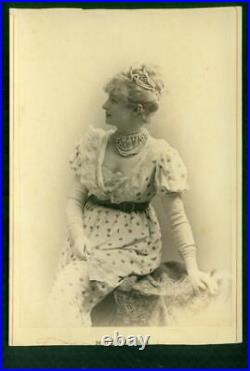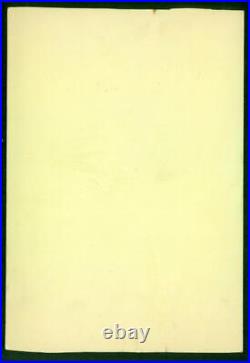



About 40 years old. Born Jadwiga Benda ; 12 October 1840 – 8 April 1909, known professionally as Helena Modjeska, was a Polish actress who specialized in Shakespearean. She was successful first on the Polish stage. After emigrating to the United States (and despite her poor command of English), she also succeeded on stage in America and London. She is regarded as the greatest actress in the history of theatre in Poland. She was also a member of the Pacific Coast Women’s Press Association. And was mother of a prominent Polish-American engineer Ralph Modjeski. Helena Modjeska was born in. On 12 October 1840. Her birth name was recorded as Jadwiga Benda, but she was later baptized Helena Opid, under her godfather’s surname. In July 1876, after spending more than a decade as the reigning diva of the Polish national theater, for reasons both personal and political, Modjeska and her husband chose to immigrate to the United States. On 20 August 1877, Modjeska debuted at the. In San Francisco in an English version of. She was seen by theatrical agent. Who signed her for a tour on the east coast where she made her New York debut. Modjeska died at Newport Beach, California on 8 April 1909, aged 68, from. Her remains were sent to Kraków to be buried in the family plot at the. Photographer: Falk, 947-949 Broadway, NY. More Info: Benjamin J. 14th Street, 947 Broadway, 13 W. Falk ascended to the first place in the world of performing arts photography. Born on October 14th, 1853, Benjamin J. Falk grew up in New York City. He graduated from the College of the City of New York with a B. In 1872, while concurrently serving as a technician under photographer George Rockwood. His first ambition was to be a graphic artist, so he attended classes at the NY Academy of Design while maintaining a studio with Jacob Schloss. Being naturally of an investigating turn of mind he interested himself in scientific studies. After making crayons for five years, he enlarged his studio into a photographic gallery. In 1881 he moved to Broadway, where the business grew rapidly, developing largely in the line of portraits of celebrities. Falk’s first studio, located on 14th street, became wholly devoted to photography in 1877. His distance from the theater district, however, prompted his 1881 relocation to 947-49 Broadway. The Broadway Studio served for 11 years until high-rises obscured the sunlight needed to maintain a day long shooting schedule, forcing him to relocate to 13-15 East 24th Street. In 1900, Falk relocated to the roof of the Waldorf Astoria. The solarium supplied superb natural light during the day, and his 25×30 operating room became the envy of the photographic fraternity. Card size: 4.25″ x 6″ (Trimmed). Was a style of photograph which was widely used for photographic portraiture after 1870. It consisted of a thin photograph mounted on a card typically measuring 108 by 165 mm (4+1? 4 by 6+1? 2 inches). The carte de visite was displaced by the larger cabinet card in the 1880s. In the early 1860s, both types of photographs were essentially the same in process and design. Both were most often albumen prints, the primary difference being the cabinet card was larger and usually included extensive logos and information on the reverse side of the card to advertise the photographer’s services. However, later into its popularity, other types of papers began to replace the albumen process. Despite the similarity, the cabinet card format was initially used for landscape views before it was adopted for portraiture. Some cabinet card images from the 1890s have the appearance of a black-and-white photograph in contrast to the distinctive sepia toning notable in the albumen print process. These photographs have a neutral image tone and were most likely produced on a matte collodion, gelatin or gelatin bromide paper. Sometimes images from this period can be identified by a greenish cast. Gelatin papers were introduced in the 1870s and started gaining acceptance in the 1880s and 1890s as the gelatin bromide papers became popular. Matte collodion was used in the same period. A true black-and-white image on a cabinet card is likely to have been produced in the 1890s or after 1900. The last cabinet cards were produced in the 1920s, even as late as 1924. Owing to the larger image size, the cabinet card steadily increased in popularity during the second half of the 1860s and into the 1870s, replacing the carte de visite as the most popular form of portraiture. The cabinet card was large enough to be easily viewed from across the room when typically displayed on a cabinet, which is probably why they became known as such in the vernacular. Whatever the name, the popular print format joined the photograph album as a fixture in the late 19th-century Victorian parlor. The Last Image is for Information Only. VG-VG/EX (Edge & corner wear, Top & bottom are trimmed). Please see scans for actual condition. This Cabinet Card would make a great addition to your collection or as a Gift (nice for Framing). Newest Collections with FREE S&H. To see all my Postcards. To see all my Movie Items. To see all my Disney Items. To see all my Baseball Items. To see all my Boy Scout Cards. To see all my Stereoview Cards. Add me to your Favorite Sellers and Sign up for my Newsletter. Ground Advantage (the old 1st class). Please look at my other Auctions for more Collectibles of the 1800’s-1900’s. Get Supersized Images & Free Image Hosting. Create your brand with Auctiva’s. Attention Sellers – Get Templates Image Hosting, Scheduling at Auctiva. Com. Track Page Views With.

